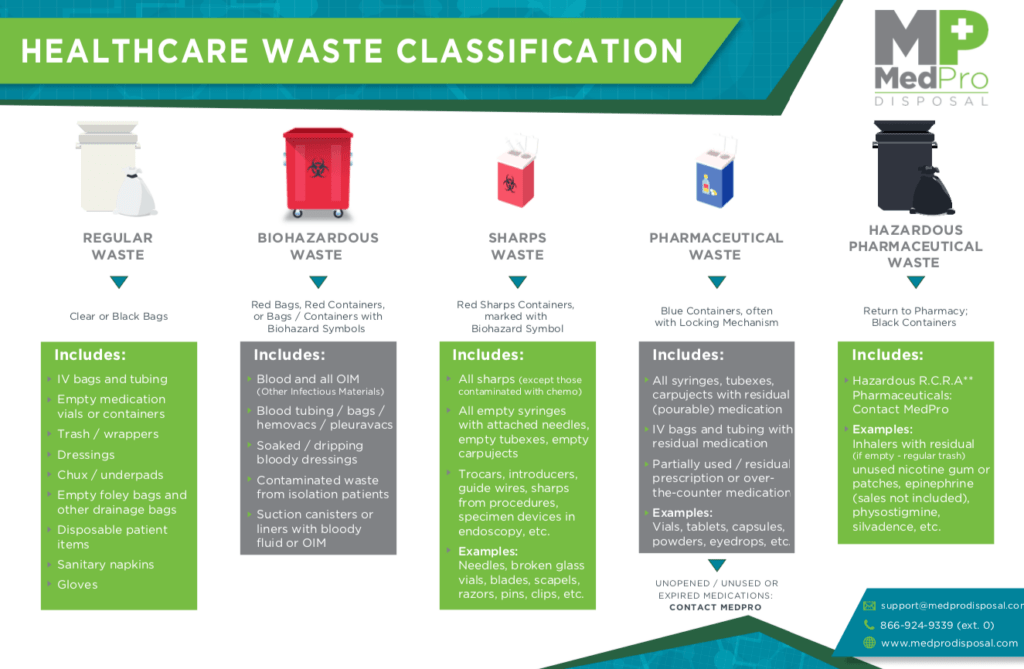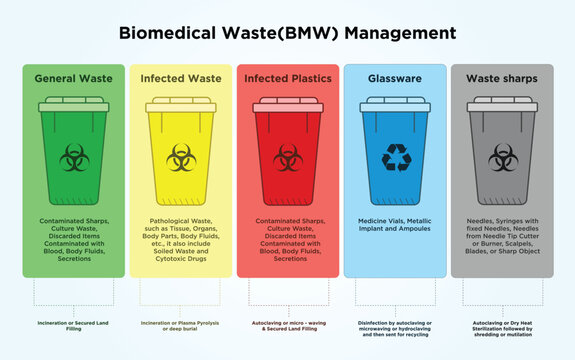Tailored Medical Waste Disposal Service: Satisfying Health Care Conformity Specifications
Wiki Article
Conformity and Rules for Medical Garbage Disposal
Compliance and regulations for medical waste disposal play a critical function in making certain the safety and security and health of both health care specialists and the general public. Proper administration of clinical waste is vital to prevent the spread of infections, secure the atmosphere, and maintain public wellness. These laws incorporate numerous aspects, including the classification and partition of medical waste, appropriate storage space and handling procedures, as well as transport and disposal approaches.Importance of Conformity
The significance of conformity with policies for clinical waste disposal can not be overemphasized. Correct disposal of medical waste is important for ensuring the security and wellness of health care workers, individuals, and the basic public. Medical waste, which includes products such as used needles, polluted handwear covers, and biomedical waste, can pose major wellness dangers if not taken care of and disposed of effectively.Compliance with laws makes sure that clinical waste is managed in a means that lessens the potential for exposure to transmittable diseases and hazardous compounds - medical waste removal service. It assists prevent the spread of infections, such as HIV, liver disease B and C, and other bloodborne virus. Compliance also plays a crucial duty in securing the setting by avoiding contamination of water sources, dirt, and air
Failure to adhere to regulations can lead to serious consequences for healthcare facilities, consisting of penalties, lawsuit, and damages to their track record. In addition, non-compliance may jeopardize the health and wellness of medical care employees, clients, and the community.
Conformity with regulations for clinical waste disposal needs adherence to certain guidelines and methods. These may consist of appropriate segregation, product packaging, labeling, and storage of medical waste. It also involves using authorized disposal approaches, such as autoclaving, incineration, or landfilling, depending upon the kind of waste.
Regulatory Agencies and Bodies
Regulative firms and bodies play a vital role in supervising compliance with laws for medical garbage disposal. These companies are accountable for setting standards, guidelines, and methods to guarantee the safe and proper handling of clinical waste. They enforce and monitor compliance to shield public health and the setting.One of the most famous governing agencies in the USA is the Epa (EPA) The EPA is accountable for controling the storage, transport, therapy, and disposal of clinical waste. They develop standards for waste generators, carriers, and therapy centers to comply with, guaranteeing that all needed safety measures are taken to stop the spread of conditions and contamination.
An additional crucial regulatory body is the Occupational Safety and Health Administration (OSHA) OSHA sets standards and regulations to secure workers from occupational threats, consisting of those relevant to medical waste. WasteX Medical Waste Disposal. They provide guidelines for the safe handling and disposal of medical waste to secure workers in healthcare centers
In addition to these federal companies, individual states additionally have their own regulative bodies that oversee medical garbage disposal. These firms might have their own certain laws and needs that should be complied with.

Classification and Partition of Medical Waste
To guarantee proper administration of medical waste, it is necessary to classify and segregate it according to established protocols and guidelines. medical waste disposal service. Category and partition play an important duty in reducing the threat of infection, securing the setting, and making sure the security of healthcare employees and the basic publicClinical waste is identified right into different categories based upon its possible threat level. These classifications consist of transmittable waste, pathological waste, sharps waste, pharmaceutical waste, chemical waste, and radioactive waste. Each group requires particular handling, disposal, transport, and storage approaches to lessen the danger of direct exposure and contamination.
Partition of medical waste includes dividing different kinds of waste at the source. This process ensures that waste with different hazard degrees is not mixed, lowering the capacity for cross-contamination and making disposal procedures extra effective. Appropriate segregation is achieved via the use of color-coded labels and containers, which aid medical care workers and waste administration personnel identify and deal with each kind of waste properly.
In addition to category and partition, health care centers have to also stick to regional, state, and federal regulations relating to clinical waste monitoring. These guidelines detail details demands for storage space, transportation, treatment, and final disposal of medical waste, making sure compliance and maintaining public health and wellness and safety.
Proper Storage Space and Taking Care Of Treatments
Appropriate storage and handling treatments play a vital function in making certain the certified and secure monitoring of clinical waste. Medical waste, which consists of products such as used syringes, infected handwear covers, and ended medications, can position serious wellness and ecological dangers if not handled appropriately. As a result, it is critical for health care facilities and other generators of medical waste to execute strict storage space and managing protocols.
To start with, clinical waste ought to be kept in long lasting, leak-proof containers that are particularly designed for this function. These containers should be identified with the global biohazard symbol visit this page and words "clinical waste" to clearly suggest the components. In addition, the containers should be maintained securely shut to avoid any prospective leak or spillage.
Moreover, it is very important to set apart different sorts of clinical waste to prevent cross-contamination. Sharps, such as scalpels and needles, need to be stored in puncture-resistant containers to reduce the danger of injuries - WasteX Medical Waste Disposal. Chemical waste, such as solvents and disinfectants, must be saved separately from other sorts of medical waste to avoid harmful exposures or chemical reactions

Transportation and Disposal Methods
Medical care facilities must ensure the risk-free transportation and correct disposal of their medical waste to adhere to guidelines and secure public health. Transport and disposal approaches play a crucial duty in avoiding the spread of contagious conditions and reducing the environmental influence of medical waste.
To transport clinical waste, health care centers must make use of watertight and puncture-resistant containers that are classified with the biohazard sign. These containers ought to be safely secured to stop any leak during transport. Additionally, health care facilities must develop methods for the transportation procedure, including making use of skilled personnel and dedicated cars.
As soon as the medical waste reaches the disposal center, it undergoes different approaches of treatment. One typical approach is incineration, which entails burning the waste at high temperature levels to destroy pathogens and minimize the quantity of waste. Another technique is autoclaving, which makes use of steam and pressure to decontaminate the waste. After treatment, the waste is commonly sent to a garbage dump or a waste-to-energy center for last disposal.
It is crucial for healthcare centers to work with licensed and permitted waste management companies to guarantee correct transport and disposal of clinical waste. These firms have the expertise and resources to handle medical waste safely and in compliance with regulations.
Verdict
To conclude, conformity with laws for clinical garbage disposal is of utmost value to make sure public health and wellness and security. Regulatory agencies and bodies play a vital function in imposing these guidelines. Appropriate classification and partition of clinical waste, in addition to complying with suitable storage and handling treatments, are important to prevent contamination and the spread of conditions. Ample transport and disposal approaches must be executed to reduce environmental influences. Generally, adherence to compliance and regulations is needed to successfully manage clinical waste.Medical waste, which consists of products such as made use of needles, infected handwear covers, and biomedical waste, can position serious health risks if not managed and disposed of correctly.
These classifications consist of infectious waste, pathological waste, sharps waste, pharmaceutical waste, chemical waste, and radioactive waste.Partition of clinical waste involves separating different types of waste at the source. Appropriate partition is achieved through the usage of color-coded labels and containers, which assist medical care employees and waste management workers handle each type and determine of waste appropriately.
Chemical waste, such as solvents and disinfectants, must be saved separately from other types of medical waste to stop chemical responses or hazardous exposures.
Report this wiki page